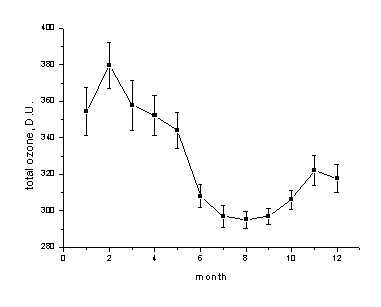
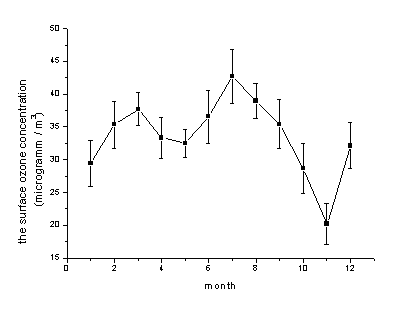
Institute of ionosphere, Kamenskoe Plateau, Almaty, Kazakhstan
e-mail: angel@ionos.alma-ata.su
FIGURES
Abstract
The back-ground measurements of total ozone and tropospheric ozone were used in the paper. The observations were carried out in the Alatau mountain near city Almaty. Spectrophotometer-ozonometer was used for observations of total ozone. The measurements of the surface ozone concentration were carried out by hemiluminiscence ozonometer. The annual variations of total ozone were shown to have the maximum in winter months, minimum in summer month and the annual variations of the surface ozone concentration have the maximum in summer, minimum in winter in this region. Such variations are typical variations for middle latitude in north hemisphere. Station of ozone monitoring is placed in zone with mountain - valley circulation. It is surrounded the city in the one side and mountain in other side. Comparison of total ozone and tropospheric ozone was carried out in period when city smog comes to the ozone station. The tropospheric ozone value was shown to increase at noon in summer while variation of total ozone are insignificant. Such daily variations of total ozone and tropospheric ozone did not observe in winter. We concluded that in city photochemical smog of the Los-Angeles type presence in summer.
Introduction
Stratosphere-Troposheric processes is important for the understanding of climate change. Stratospheric ozone is known to determine biological active ultraviolet solar radiation on Earth surface [Perov et.al., 1980; Khrgian, 1973].
Lately some interest are take place to tropospheric ozone and its relation to stratospheric ozone [Ivlev, 1990;Kiehl, 1999]. It is connected with strong chemical and biological ozone activity. Besides, ozone absorbing radiation from Earth surface is green gas.Ozone is able to be formed by chemical processes into smog of Los-Angeles type.
In present paper daily and annual variations of total ozone and of surface ozone concentration were analysed, is investigated dynamics of ozone in periods when city smog comes to the ozone station (1317 m above sea-level). Ozone station is in the Alatau mountain near city Almaty.
Annual variations of total ozone and the surface ozone concentration
The back-ground measurements of total ozone and the surface ozone concentration were used for investigation of ozone variations. Spectrophotometer-ozonometer, constructed on double quartz monochromator, has been used to spectral the measurements of total ozone [Bekturganov et. al.,1977].
Total ozone was calculated by the multi-wavelength's technique
[Kuznetsov, 1975].
Value of the surface ozone concentration was carried out by standart
hemiluminiscence ozonometer.
Month-mean value of total ozone and the surface ozone concentration
was calculated over the years 1993-1997. Figure 1 for total ozone
and figure 2 for the surface ozone concentration shows the annual
cycle of calculated values.
 |
Figure 1. Mean annual cycle of total ozone. |
 |
Figure 2. Annual cycle of the surface ozone concentration in the Alatau mountain. |
Curves of annual cycle are typical for the ozone behavior of middle
latitude of northern hemisphere.
Here is pronounced maximum of total ozone in winter (February),
when mean value of total ozone reach 390 D.U. Then it takes place
sharp decrease of total ozone to minimum. The minimum of total
ozone is gently sloping and illegible in summer (august). The
mean value of total ozone fluctuates from 280 D.U. to 300 D.U.
Annual cycle of the surface ozone concentration is defined by
maximum in spring-summer time (July) and minimum in autum-winter
time (November).
Daily variations of total ozone and the surface ozone concentration
Figure 3 shows daily variations of total ozone. Change of total
ozone is insignificant during day in a different seasons.
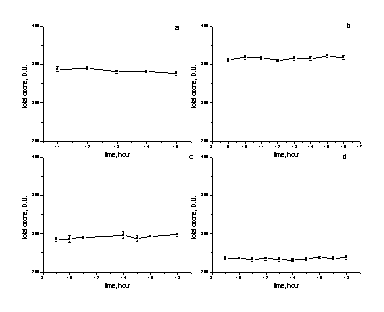 |
Figure 3.Daily value of total ozone:a-winter (22.01.1997); b-spring (24.03.1994); c-summer (25.07.1997); d- autumn (21.09.1994). |
Daily variations of the surface ozone concetration were demonstrated
in figure 4. The noticeable noon increase of the surface ozone
concentration is observed in summer and least variations in winter.
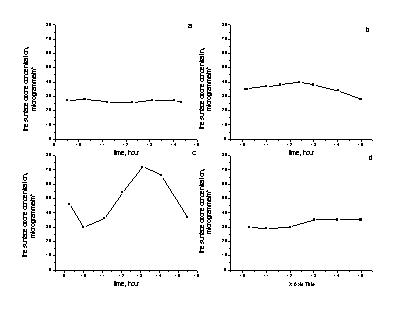 |
Figure 4.Daily value of the surface ozone concentration:a-winter (05.01.1994); b-spring (11.05.1995); c-summer (06.06.1994); d- autumn (11.10.1994). |
Such behaviour of the surface ozone concentration is able to explain
by variations of the solar flux and photochemical nature of ozone.
In summer the solar flux is increased in noon and conduces the
increase of the surface ozone concentration. In winter the solar
flux is changed less than in summer.
Observations of total ozone and the surface ozone concentration
are interesting in period when city smog comes to the ozone station.
Ozone station is placed in zone with mountain-valley circulation.
In morning the ozone station is in zone of the clean mountain
air. During day the city smog comes to the ozone station. In city
Almaty the photochemistry smog will able to be expected because
of combustion gases and the high solar flux in summer.
City air coming to ozone station leads to significant increase
of the surface ozone concentration. In such periods the measurements
of total ozone, atmospheric pollution and the surface ozone concentration
were carried out at same time. Figure 5 shows the behaviour of
measurement values.
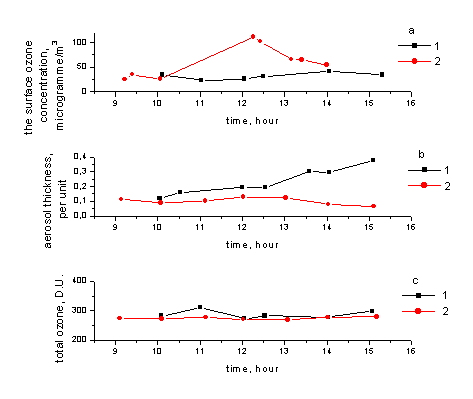 |
Figure 5.Variation of total ozone, the surface ozone concentration and aerosol thickness in period when city smog comes in ozone station (1-winter;2- summer):a- the surface ozone concentration; b-aerosol thickness; c-total ozone. |
One can see that value of total ozone is constant during day, atmospheric pollution is increasing and the noon value of the surfase ozone concentration is increased in summer. Such behaviour of the surface ozone concentration confirm the presenting photochemistry smog of Los-Angeles type in city Almaty. In winter the city smog does not lead to the noticeable increase of the surface ozone concentration. Apparently two processes compete in winter: ozone formation as result of photochemistry reaction and ozone destruction on aerosols. Aerosol concentration are sharply increasing in winter.
Conclusions
Thus annual cycle of total ozone is defined by winter maximum and summer minimum. During day total ozone has insignificant variations. Annual cycle of the surface ozone concentration has summer maximum and winter minimum. Daily variations of the surface ozone concentration is shown its noon increase in summer. Atmospheric pollution promotes ozone formation in summer and decrease of ozone in winter in Almaty city.It is drawn the conclusion about the presenting photochemistry smog of Los-Angeles type in city Almaty in summer.
Acknowledgements
I am gratefully to professor Ivanov A.I. for disscustions of work results. And also I thank Korovchenko V.N. for the submitted data of the surface ozone concentration.
References
Perov S.P., Khrgian A.Kh., The modern Problems of atmospheric ozone. 287,1980.
Khrgian A.Kh.,Physics of atmospheric ozone. 291,1973.
Ivlev A.S., Temporary variability of the surface ozone concentration in low atmosphere. 86-101,1990.
Kiehl J.T.,Schneider T.L., Portmann R.W. and Solomon S., Climate forcing due to tropospheric and stratospheric ozone. J. Geophys. Res., 104, 31239-31254, 1999.
Bekturganov B.K., Ivanov A.I., Korovchenko V.N.,Spectrophotometer-ozonometer on base of double quarz monochromator DMR-4. J. Some questions of solid body physics and optics, 12-17, 1977.
Kuznetsov G.I., Multi-wavelength's technique and instruments for observations of atmospheric ozone and aerosol. Atmospheric and Oceanic Physics. 11, 6, 647-651, 1975.
Back to
| Session 1 : Stratospheric Processes and their Role in Climate | Session 2 : Stratospheric Indicators of Climate Change |
| Session 3 : Modelling and Diagnosis of Stratospheric Effects on Climate | Session 4 : UV Observations and Modelling |
| AuthorData | |
| Home Page | |